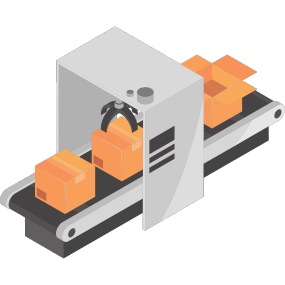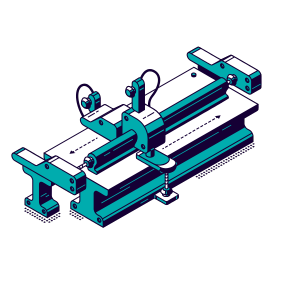Courses

Our Courses
- Our Courses
Edit Content

DIPLOMA IN INDUSTRIAL AUTOMATION
DURATION : 30 DAYS (60 Hrs.)
PLC – Any 1 brand of PLC
(Schneider, Siemens, Delta)
SCADA-1, HMI-1, VFD-1 .

CERTIFIED AUTOMATION ENGINEER
DURATION : 1.5 MONTHS (120Hrs.)
PLC – Any 2 brands of PLC
(Schneider, Allen Bradley, Siemens, Delta)
SCADA-1 , HMI-2 , VFD-2 .

ADVANCED AUTOMATION SYSTEM PROFESSIONAL
DURATION : 2 MONTHS (160Hrs.)
PLC – Any 3 brands of PLC( Schneider, Allen
Bradley, Siemens, Delta, ), SCADA-1 , HMI-2 ,
VFD-2 .

MASTER OF INDUSTRIAL AUTOMATION
DURATION : 3 MONTHS (240Hrs.)
PLC – 4 brands of PLC( Schneider,
Allen Bradley, Siemens, Delta),
SCADA, HMI, VFD, PLC Wiring and
Control Panel Wiring and IIOT
Concepts.

EXPERT-LEVEL TROUBLESHOOTING & MAINTENANCE
DURATION : 1 MONTHS (60Hrs.)
Preventive Maintenance
Maintenance Schedule preparation
Electrical Control Circuit
Development Electrical
VFD Drive Installation &
Energy Monitoring System using
SCADA Troubleshooting PLC
Corrective Actions PLC Error Codes
Troubleshooting
Edit Content

DIPLOMA IN INDUSTRIAL AUTOMATION
DURATION : 30 DAYS (60 Hrs.)
PLC – Any 1 brand of PLC
(Schneider, Siemens, Delta)
SCADA-1, HMI-1, VFD-1 .
Week 1 Fundamentals of Electrical Engineering
- Introduction to Electrical Engineering
- Applications used in industries
- Basic Concepts of Electricity
- Ohm’s Law
- Electrical Components and Symbols
- Electrical Circuit Analysis
- Relay logics and circuits
- Series and Parallel Circuits
- Voltage, Current, and Resistance
- Power and Energy in Electrical Systems
- Electrical machines(Motors and Types)
- Electrical Safety Practices
- Contactor – Latching/ Holding/ Retaining
- Timer – On delay/ OFF delay
- OLR, and SMPS
- Necessity of Motor Starters
- Direct online starters
- Motor – Forward Reversal with Interlocks
- Star-delta Starter
- Importance of Relay
- Relay
- Latching/ Holding/ Retaining
- Relay wiring with Logic gates
- Limit switch
- Reed switch
- Solenoid
- Actuators
Week 2 Basics of PLC
- Overview
- Introduction to PLC
- Advantages of PLC Control Panel
- Architecture of PLC
- Working principle of PLC
- PLC type and selection details
- Hardware configuration
- Software Explanation
- Communication details
- Online & Diagnostics
- Memory management
- Different types of Inputs and Outputs
- Concept of Digital I/O
- Concept of Analog I/O
- Concept of PLC scan cycle
- Maintenance and troubleshooting of PLC
- Selection of PLC
- Wiring of PLC
- Source type input wiring
- Sink type input wiring
- Transistor type output wiring
- Relay type output wiring
- Various transmitters / sensors used in industrial applications
- Position sensor: Photo electric, proximity sensor, encoder)
- working principle, types selection guidelines
- Flow measurement, working principle, types, selection guidelines
- Pressure measurement, working principle, types, selection guidelines
- Load measurement, load cells
- Level measurement, working principle, types, selection guidelines
- Solenoid valves, control valves, smart transmitters
- Instrument transformers (CT,VT)
- Process control basics, closed & open loop control
- Process controllers (on-off, proportional, PID.
Week 3 PLC Programming & VFD
- Programming Language – Ladder diagram
- Device configuration – Start / Stop CPU
- Addressing details Digital, I/O’s
- Addressing details Analog, I/O’s
- Data Types – Bool, Integer, Real, Word, Dword
- Compile –Download, Upload program
- Bit logic – NO, NC, NOT, SET, RESET, POSITIVE & NEGATIVE EDGE
- Timer – ON Delay, OFF Delay, Retentive Timer, Pulse Timer
- Counter – UP Counter, Down Counter, UPDOWN Counter
- Comparator – >, <, =
- Move Function
- Data type Conversion – ROUND, TRUNC, CEIL, FLOOR
- Math Functions – ADD, SUB, MUL, DIV, MOD, ABS, NEG
- Program control – CJ, CALL, LABEL, RETURN, MC, MCR.
- Programming Language – Ladder diagram, FBD, STL
- Function Block, Functions – OB, FB, FC, DB
- Table, Cross reference
- Analog Configuration
- Analog signals 0v to 10v DC, 4mA to 20mA DC
- Adjusting gain & offset in A/D conversion
- Adjusting gain & offset in D/A conversion
- Scale function
- PID Configuration
- Real Time Clock – RTC
- High Speed Counter – HSC
- Pulse Train Output – PTO
- Libraries
- PDF conversion
- Real Time Applications
- Understanding the basic techniques of controlling an AC motor.
- Block Diagram of VFD
- How an AC drive is constructed, and how the various protection features work
- Operation of the AC drive.
- AC drive range and specification.
- Motor Nameplate – Drive
- Modes of Control
- V/F Control
- Speed & Torque
- Vector control
- Auto Tuning / ID Run
- Frequency Reference Setting
- Acceleration and De-Acceleration Control
- Forward and Reverse control
- Monitor / Display parameter
- Parameter Selection
- Parameter programming
- Set points
- Multi-speed control
- External speed control by Analog Input / Analog output
- Remote control
- Jogging concept
- Dynamic Braking
- Master slave concept
- Braking resistor
- Communication with PLC
Week 4 HMI & SCADA
- Getting started with HMI
- Creating applications, creating tags
- Downloading /uploading programs
- Creating alarm messages
- Communication with PLC
- Fault diagnostics
- New Window Creation & Linking.
- Button Creation and design.
- Output Design.
- Numeric Scaling and Demonstration.
- Multi-State Word Lamps and Switches.
- Alarm creation.
- Log Creation and Monitoring.
- Admin and User Role Creation and Security Assigned
- Trend Graph.
- Controlling field Devices.
- Tricks & Tips.
- Introduction to HMI / SCADA
- Software Explanation
- Download and uploading the programs
- IP address configuration
- Making New Project
- Features of SCADA.
- Difference Between SCADA and HMI
- Difference Between SCADA and PLC
- Making and Editing New Graphic Display
- Scada Tags – Memory, I/O, Discrete, Real, Integer, message
- Runtime, Development
- Animation
- Movement, Filling, Visibility, Blinking, Orientation, Height width,
- Tag creation
- Trend Details
- Real-time trend
- Historical trend
- Function Keys
- DDE / Suite link protocols
- Alarms and Events Details
- Security Control.
- Activity Recap
- Role plays and Feedback
- Trainer Insights
- Closing Remark
Edit Content

CERTIFIED AUTOMATION ENGINEER
DURATION : 1.5 MONTHS (120Hrs.)
PLC – Any 2 brands of PLC
(Schneider, Allen Bradley, Siemens, Delta)
SCADA-1 , HMI-1 , VFD-2 .
Week 1 Fundamentals of Electrical Engineering
- Introduction to Electrical Engineering
- Applications used in industries
- Basic Concepts of Electricity
- Ohm’s Law
- Electrical Components and Symbols
- Electrical Circuit Analysis
- Relay logics and circuits
- Series and Parallel Circuits
- Voltage, Current, and Resistance
- Power and Energy in Electrical Systems
- Electrical machines(Motors and Types)
- Electrical Safety Practices
- Contactor – Latching/ Holding/ Retaining
- Timer – On delay/ OFF delay
- OLR, and SMPS
- Necessity of Motor Starters
- Direct online starters
- Motor – Forward Reversal with Interlocks
- Star-delta Starter
- Importance of Relay
- Relay
- Latching/ Holding/ Retaining
- Relay wiring with Logic gates
- Limit switch
- Reed switch
- Solenoid
- Actuators
Week 2 Basics of PLC
- Overview
- Introduction to PLC
- Advantages of PLC Control Panel
- Architecture of PLC
- Working principle of PLC
- PLC type and selection details
- Hardware configuration
- Software Explanation
- Communication details
- Online & Diagnostics
- Memory management
- Different types of Inputs and Outputs
- Concept of Digital I/O
- Concept of Analog I/O
- Concept of PLC scan cycle
- Maintenance and troubleshooting of PLC
- Selection of PLC
- Wiring of PLC
- Source type input wiring
- Sink type input wiring
- Transistor type output wiring
- Relay type output wiring
- Various transmitters / sensors used in industrial applications
- Position sensor: Photo electric, proximity sensor, encoder)
- working principle, types selection guidelines
- Flow measurement, working principle, types, selection guidelines
- Pressure measurement, working principle, types, selection guidelines
- Load measurement, load cells
- Level measurement, working principle, types, selection guidelines
- Solenoid valves, control valves, smart transmitters
- Instrument transformers (CT,VT)
- Process control basics, closed & open loop control
- Process controllers (on-off, proportional, PID.
Week 3 PLC Programming & VFD (Brand 1)
- Programming Language – Ladder diagram
- Device configuration – Start / Stop CPU
- Addressing details Digital, I/O’s
- Addressing details Analog, I/O’s
- Data Types – Bool, Integer, Real, Word, Dword
- Compile –Download, Upload program.
- Bit logic – NO, NC, NOT, SET, RESET, POSITIVE & NEGATIVE EDGE
- Timer – ON Delay, OFF Delay, Retentive Timer, Pulse Timer
- Counter – UP Counter, Down Counter, UPDOWN Counter
- Comparator – >, <, =
- Move Function
- Data type Conversion – ROUND, TRUNC, CEIL, FLOOR
- Math Functions – ADD, SUB, MUL, DIV, MOD, ABS, NEG
- Program control – CJ, CALL, LABEL, RETURN, MC, MCR
- Programming Language – Ladder diagram, FBD, STL
- Function Block, Functions – OB, FB, FC, DB
- Table, Cross reference
- Analog Configuration
- Analog signals 0v to 10v DC, 4mA to 20mA DC
- Adjusting gain & offset in A/D conversion
- Adjusting gain & offset in D/A conversion
- Scale function
- PID Configuration
- Real Time Clock – RTC
- High Speed Counter – HSC
- Pulse Train Output – PTO
- Libraries
- PDF conversion
- Real Time Applications
- Understanding the basic techniques of controlling an AC motor.
- Block Diagram of VFD
- How an AC drive is constructed, and how the various protection features work
- Operation of the AC drive.
- AC drive range and specification.
- Motor Nameplate – Drive
- Modes of Control
- V/F Control
- Speed & Torque
- Vector control
- Auto Tuning / ID Run
- Frequency Reference Setting
- Acceleration and De-Acceleration Control
- Forward and Reverse control
- Monitor / Display parameter
- Parameter Selection
- Parameter programming
- Set points
- Multi-speed control
- External speed control by Analog Input / Analog output
- Remote control
- Jogging concept
- Dynamic Braking
- Master slave concept
- Braking resistor
- Communication with PLC
Week 4 PLC Programming & VFD (Brand 2)
- Programming Language – Ladder diagram
- Device configuration – Start / Stop CPU
- Addressing details Digital, I/O’s
- Addressing details Analog, I/O’s
- Data Types – Bool, Integer, Real, Word, Dword
- Compile –Download, Upload program.
- Bit logic – NO, NC, NOT, SET, RESET, POSITIVE & NEGATIVE EDGE
- Timer – ON Delay, OFF Delay, Retentive Timer, Pulse Timer
- Counter – UP Counter, Down Counter, UPDOWN Counter
- Comparator – >, <, =
- Move Function
- Data type Conversion – ROUND, TRUNC, CEIL, FLOOR
- Math Functions – ADD, SUB, MUL, DIV, MOD, ABS, NEG
- Program control – CJ, CALL, LABEL, RETURN, MC, MCR
- Programming Language – Ladder diagram, FBD, STL
- Function Block, Functions – OB, FB, FC, DB
- Table, Cross reference
- Analog Configuration
- Analog signals 0v to 10v DC, 4mA to 20mA DC
- Adjusting gain & offset in A/D conversion
- Adjusting gain & offset in D/A conversion
- Scale function
- PID Configuration
- Real Time Clock – RTC
- High Speed Counter – HSC
- Pulse Train Output – PTO
- Libraries
- PDF conversion
- Real Time Applications
- Understanding the basic techniques of controlling an AC motor.
- Block Diagram of VFD
- How an AC drive is constructed, and how the various protection features work
- Operation of the AC drive.
- AC drive range and specification.
- Motor Nameplate – Drive
- Modes of Control
- V/F Control
- Speed & Torque
- Vector control
- Auto Tuning / ID Run
- Frequency Reference Setting
- Acceleration and De-Acceleration Control
- Forward and Reverse control
- Monitor / Display parameter
- Parameter Selection
- Parameter programming
- Set points
- Multi-speed control
- External speed control by Analog Input / Analog output
- Remote control
- Jogging concept
- Dynamic Braking
- Master slave concept
- Braking resistor
- Communication with PLC
Week 5 HMI (Brand 1)
- Programming Language – Ladder diagram
- Device configuration – Start / Stop CPU
- Addressing details Digital, I/O’s
- Addressing details Analog, I/O’s
- Data Types – Bool, Integer, Real, Word, Dword
- Compile –Download, Upload program.
- Bit logic – NO, NC, NOT, SET, RESET, POSITIVE & NEGATIVE EDGE
- Timer – ON Delay, OFF Delay, Retentive Timer, Pulse Timer
- Counter – UP Counter, Down Counter, UPDOWN Counter
- Comparator – >, <, =
- Move Function
- Data type Conversion – ROUND, TRUNC, CEIL, FLOOR
- Math Functions – ADD, SUB, MUL, DIV, MOD, ABS, NEG
- Program control – CJ, CALL, LABEL, RETURN, MC, MCR
- Programming Language – Ladder diagram, FBD, STL
- Function Block, Functions – OB, FB, FC, DB
- Table, Cross reference
- Analog Configuration
- Analog signals 0v to 10v DC, 4mA to 20mA DC
- Adjusting gain & offset in A/D conversion
- Adjusting gain & offset in D/A conversion
- Scale function
- PID Configuration
- Real Time Clock – RTC
- High Speed Counter – HSC
- Pulse Train Output – PTO
- Libraries
- PDF conversion
- Real Time Applications
- Understanding the basic techniques of controlling an AC motor.
- Block Diagram of VFD
- How an AC drive is constructed, and how the various protection features work
- Operation of the AC drive.
- AC drive range and specification.
- Motor Nameplate – Drive
- Modes of Control
- V/F Control
- Speed & Torque
- Vector control
- Auto Tuning / ID Run
- Frequency Reference Setting
- Acceleration and De-Acceleration Control
- Forward and Reverse control
- Monitor / Display parameter
- Parameter Selection
- Parameter programming
- Set points
- Multi-speed control
- External speed control by Analog Input / Analog output
- Remote control
- Jogging concept
- Dynamic Braking
- Master slave concept
- Braking resistor
- Communication with PLC
Week 6 SCADA
- Introduction to HMI / SCADA
- Software Explanation
- Download and uploading the programs.
- IP address configuration
- Making New Project
- Features of SCADA
- Difference Between SCADA and HMI
- Difference Between SCADA and PLC
- Making and Editing New Graphic Display
- Scada Tags – Memory, I/O, Discrete, Real, Integer, message
- Runtime, Development
- Animation
- Movement, Filling, Visibility, Blinking, Orientation, Height width,
- Tag creation
- Trend Details
- Real-time trend
- Historical trend
- Function Keys
- DDE / Suite link protocols
- Alarms and Events Details
- Security Control
Edit Content

ADVANCED AUTOMATION SYSTEM PROFESSIONAL
DURATION : 2 MONTHS (160Hrs.)
PLC – Any 3 brands of PLC( Schneider, Allen
Bradley, Siemens, Delta, ), SCADA-1 , HMI-2 ,
VFD-2 .
Week 1 Fundamentals of Electrical Engineering
- Introduction to Electrical Engineering
- Applications used in industries
- Basic Concepts of Electricity
- Ohm’s Law
- Electrical Components and Symbols
- Electrical Circuit Analysis
- Relay logics and circuits
- Series and Parallel Circuits
- Voltage, Current, and Resistance
- Power and Energy in Electrical Systems
- Electrical machines(Motors and Types)
- Electrical Safety Practices
- Contactor – Latching/ Holding/ Retaining
- Timer – On delay/ OFF delay
- OLR, and SMPS
- Necessity of Motor Starters
- Direct online starters
- Motor – Forward Reversal with Interlocks
- Star-delta Starter
- Importance of Relay
- Relay
- Latching/ Holding/ Retaining
- Relay wiring with Logic gates
- Limit switch
- Reed switch
- Solenoid
- Actuators
Week 2 Basics of PLC
- Overview
- Introduction to PLC
- Advantages of PLC Control Panel
- Architecture of PLC
- Working principle of PLC
- PLC type and selection details
- Hardware configuration
- Software Explanation
- Communication details
- Online & Diagnostics
- Memory management
- Different types of Inputs and Outputs
- Concept of Digital I/O
- Concept of Analog I/O
- Concept of PLC scan cycle
- Maintenance and troubleshooting of PLC
- Selection of PLC
- Wiring of PLC
- Source type input wiring
- Sink type input wiring
- Transistor type output wiring
- Relay type output wiring
- Various transmitters / sensors used in industrial applications
- Position sensor: Photo electric, proximity sensor, encoder)
- working principle, types selection guidelines
- Flow measurement, working principle, types, selection guidelines
- Pressure measurement, working principle, types, selection guidelines
- Load measurement, load cells
- Level measurement, working principle, types, selection guidelines
- Solenoid valves, control valves, smart transmitters
- Instrument transformers (CT,VT)
- Process control basics, closed & open loop control
- Process controllers (on-off, proportional, PID.
Week 3 PLC Programming & VFD (Brand 1)
- Programming Language – Ladder diagram
- Device configuration – Start / Stop CPU
- Addressing details Digital, I/O’s
- Addressing details Analog, I/O’s
- Data Types – Bool, Integer, Real, Word, Dword
- Compile –Download, Upload program.
- Bit logic – NO, NC, NOT, SET, RESET, POSITIVE & NEGATIVE EDGE
- Timer – ON Delay, OFF Delay, Retentive Timer, Pulse Timer
- Counter – UP Counter, Down Counter, UPDOWN Counter
- Comparator – >, <, =
- Move Function
- Data type Conversion – ROUND, TRUNC, CEIL, FLOOR
- Math Functions – ADD, SUB, MUL, DIV, MOD, ABS, NEG
- Program control – CJ, CALL, LABEL, RETURN, MC, MCR
- Programming Language – Ladder diagram, FBD, STL
- Function Block, Functions – OB, FB, FC, DB
- Table, Cross reference
- Analog Configuration
- Analog signals 0v to 10v DC, 4mA to 20mA DC
- Adjusting gain & offset in A/D conversion
- Adjusting gain & offset in D/A conversion
- Scale function
- PID Configuration
- Real Time Clock – RTC
- High Speed Counter – HSC
- Pulse Train Output – PTO
- Libraries
- PDF conversion
- Real Time Applications
- Understanding the basic techniques of controlling an AC motor.
- Block Diagram of VFD
- How an AC drive is constructed, and how the various protection features work
- Operation of the AC drive.
- AC drive range and specification.
- Motor Nameplate – Drive
- Modes of Control
- V/F Control
- Speed & Torque
- Vector control
- Auto Tuning / ID Run
- Frequency Reference Setting
- Acceleration and De-Acceleration Control
- Forward and Reverse control
- Monitor / Display parameter
- Parameter Selection
- Parameter programming
- Set points
- Multi-speed control
- External speed control by Analog Input / Analog output
- Remote control
- Jogging concept
- Dynamic Braking
- Master slave concept
- Braking resistor
- Communication with PLC
Week 4 PLC Programming & VFD (Brand 1)
- Programming Language – Ladder diagram
- Device configuration – Start / Stop CPU
- Addressing details Digital, I/O’s
- Addressing details Analog, I/O’s
- Data Types – Bool, Integer, Real, Word, Dword
- Compile –Download, Upload program.
- Bit logic – NO, NC, NOT, SET, RESET, POSITIVE & NEGATIVE EDGE
- Timer – ON Delay, OFF Delay, Retentive Timer, Pulse Timer
- Counter – UP Counter, Down Counter, UPDOWN Counter
- Comparator – >, <, =
- Move Function
- Data type Conversion – ROUND, TRUNC, CEIL, FLOOR
- Math Functions – ADD, SUB, MUL, DIV, MOD, ABS, NEG
- Program control – CJ, CALL, LABEL, RETURN, MC, MCR
- Programming Language – Ladder diagram, FBD, STL
- Function Block, Functions – OB, FB, FC, DB
- Table, Cross reference
- Analog Configuration
- Analog signals 0v to 10v DC, 4mA to 20mA DC
- Adjusting gain & offset in A/D conversion
- Adjusting gain & offset in D/A conversion
- Scale function
- PID Configuration
- Real Time Clock – RTC
- High Speed Counter – HSC
- Pulse Train Output – PTO
- Libraries
- PDF conversion
- Real Time Applications
- Understanding the basic techniques of controlling an AC motor.
- Block Diagram of VFD
- How an AC drive is constructed, and how the various protection features work
- Operation of the AC drive.
- AC drive range and specification.
- Motor Nameplate – Drive
- Modes of Control
- V/F Control
- Speed & Torque
- Vector control
- Auto Tuning / ID Run
- Frequency Reference Setting
- Acceleration and De-Acceleration Control
- Forward and Reverse control
- Monitor / Display parameter
- Parameter Selection
- Parameter programming
- Set points
- Multi-speed control
- External speed control by Analog Input / Analog output
- Remote control
- Jogging concept
- Dynamic Braking
- Master slave concept
- Braking resistor
- Communication with PLC
Week 5 PLC Programming (Brand 3)
- Programming Language – Ladder diagram
- Device configuration – Start / Stop CPU
- Addressing details Digital, I/O’s
- Addressing details Analog, I/O’s
- Data Types – Bool, Integer, Real, Word, Dword
- Compile –Download, Upload program.
- Bit logic – NO, NC, NOT, SET, RESET, POSITIVE & NEGATIVE EDGE
- Timer – ON Delay, OFF Delay, Retentive Timer, Pulse Timer
- Counter – UP Counter, Down Counter, UPDOWN Counter
- Comparator – >, <, =
- Move Function
- Data type Conversion – ROUND, TRUNC, CEIL, FLOOR
- Math Functions – ADD, SUB, MUL, DIV, MOD, ABS, NEG
- Program control – CJ, CALL, LABEL, RETURN, MC, MCR
- Programming Language – Ladder diagram, FBD, STL
- Function Block, Functions – OB, FB, FC, DB
- Table, Cross reference
- Analog Configuration
- Analog signals 0v to 10v DC, 4mA to 20mA DC
- Adjusting gain & offset in A/D conversion
- Adjusting gain & offset in D/A conversion
- Scale function
- PID Configuration
- Real Time Clock – RTC
- High Speed Counter – HSC
- Pulse Train Output – PTO
- Libraries
- PDF conversion
- Real Time Applications
- Comparation of PLCs
- Reviews
- Discussion
Week 6 HMI (Brand 1)
- Getting started with HMI
- Creating applications, creating tags
- Downloading /uploading programs.
- Creating alarm messages
- Communication with PLC
- Fault diagnostics
- New Window Creation & Linking.
- Button Creation and design.
- Output Design.
- Numeric Scaling and Demonstration.
- Multi-State Word Lamps and Switches.
- Alarm creation.
- Log Creation and Monitoring.
- Admin and User Role Creation and Security Assigned
- Trend Graph.
- Controlling field Devices.
- Tricks & Tips.
Week 7 HMI (Brand 2)
- Getting started with HMI
- Creating applications, creating tags
- Downloading /uploading programs.
- Creating alarm messages
- Communication with PLC
- Fault diagnostics
- New Window Creation & Linking.
- Button Creation and design.
- Output Design.
- Numeric Scaling and Demonstration.
- Multi-State Word Lamps and Switches.
- Alarm creation.
- Log Creation and Monitoring.
- Admin and User Role Creation and Security Assigned
- Trend Graph.
- Controlling field Devices.
- Tricks & Tips.
Week 8 SCADA
- Introduction to HMI / SCADA
- Software Explanation
- Download and uploading the programs.
- IP address configuration
- Making New Project
- Features of SCADA
- Difference Between SCADA and HMI
- Difference Between SCADA and PLC
- Making and Editing New Graphic Display
- Scada Tags – Memory, I/O, Discrete, Real, Integer, message
- Runtime, Development
- Animation
- Movement, Filling, Visibility, Blinking, Orientation, Height width,
- Tag creation
- Trend Details
- Real-time trend
- Historical trend
- Function Keys
- DDE / Suite link protocols
- Alarms and Events Details
- Security Control
Edit Content

MASTER OF INDUSTRIAL AUTOMATION
DURATION : 3 MONTHS (240Hrs.)
PLC – 4 brands of PLC( Schneider,
Allen Bradley, Siemens, Delta),
SCADA, HMI, VFD, PLC Wiring and
Control Panel Wiring and IIOT
Concepts.
Week 1 Fundamentals of Electrical Engineering
- Introduction to Electrical Engineering
- Applications used in industries
- Basic Concepts of Electricity
- Ohm’s Law
- Electrical Components and Symbols
- Electrical Circuit Analysis
- Relay logics and circuits
- Series and Parallel Circuits
- Voltage, Current, and Resistance
- Power and Energy in Electrical Systems
- Electrical machines(Motors and Types)
- Electrical Safety Practices
- Contactor – Latching/ Holding/ Retaining
- Timer – On delay/ OFF delay
- OLR, and SMPS
- Necessity of Motor Starters
- Direct online starters
- Motor – Forward Reversal with Interlocks
- Star-delta Starter
- Importance of Relay
- Relay
- Latching/ Holding/ Retaining
- Relay wiring with Logic gates
- Limit switch
- Reed switch
- Solenoid
- Actuators
Week 2 Basics of PLC
- Overview
- Introduction to PLC
- Advantages of PLC Control Panel
- Architecture of PLC
- Working principle of PLC
- PLC type and selection details
- Hardware configuration
- Software Explanation
- Communication details
- Online & Diagnostics
- Memory management
- Different types of Inputs and Outputs
- Concept of Digital I/O
- Concept of Analog I/O
- Concept of PLC scan cycle
- Maintenance and troubleshooting of PLC
- Selection of PLC
- Wiring of PLC
- Source type input wiring
- Sink type input wiring
- Transistor type output wiring
- Relay type output wiring
- Various transmitters / sensors used in industrial applications
- Position sensor: Photo electric, proximity sensor, encoder)
- working principle, types selection guidelines
- Flow measurement, working principle, types, selection guidelines
- Pressure measurement, working principle, types, selection guidelines
- Load measurement, load cells
- Level measurement, working principle, types, selection guidelines
- Solenoid valves, control valves, smart transmitters
- Instrument transformers (CT,VT)
- Process control basics, closed & open loop control
- Process controllers (on-off, proportional, PID.
Week 3 PLC Programming (Brand 1)
- Programming Language – Ladder diagram
- Device configuration – Start / Stop CPU
- Addressing details Digital, I/O’s
- Addressing details Analog, I/O’s
- Data Types – Bool, Integer, Real, Word, Dword
- Compile –Download, Upload program.
- Bit logic – NO, NC, NOT, SET, RESET, POSITIVE & NEGATIVE EDGE
- Timer – ON Delay, OFF Delay, Retentive Timer, Pulse Timer
- Counter – UP Counter, Down Counter, UPDOWN Counter
- Comparator – >, <, =
- Move Function
- Data type Conversion – ROUND, TRUNC, CEIL, FLOOR
- Math Functions – ADD, SUB, MUL, DIV, MOD, ABS, NEG
- Program control – CJ, CALL, LABEL, RETURN, MC, MCR
- Programming Language – Ladder diagram, FBD, STL
- Function Block, Functions – OB, FB, FC, DB
- Table, Cross reference
- Analog Configuration
- Analog signals 0v to 10v DC, 4mA to 20mA DC
- Adjusting gain & offset in A/D conversion
- Adjusting gain & offset in D/A conversion
- Scale function
- PID Configuration
- Real Time Clock – RTC
- High Speed Counter – HSC
- Pulse Train Output – PTO
- Libraries
- PDF conversion
- Real Time Applications
- Comparation of PLCs
- Reviews
- Discussion
Week 4 PLC Programming (Brand 2)
- Programming Language – Ladder diagram
- Device configuration – Start / Stop CPU
- Addressing details Digital, I/O’s
- Addressing details Analog, I/O’s
- Data Types – Bool, Integer, Real, Word, Dword
- Compile –Download, Upload program.
- Bit logic – NO, NC, NOT, SET, RESET, POSITIVE & NEGATIVE EDGE
- Timer – ON Delay, OFF Delay, Retentive Timer, Pulse Timer
- Counter – UP Counter, Down Counter, UPDOWN Counter
- Comparator – >, <, =
- Move Function
- Data type Conversion – ROUND, TRUNC, CEIL, FLOOR
- Math Functions – ADD, SUB, MUL, DIV, MOD, ABS, NEG
- Program control – CJ, CALL, LABEL, RETURN, MC, MCR
- Programming Language – Ladder diagram, FBD, STL
- Function Block, Functions – OB, FB, FC, DB
- Table, Cross reference
- Analog Configuration
- Analog signals 0v to 10v DC, 4mA to 20mA DC
- Adjusting gain & offset in A/D conversion
- Adjusting gain & offset in D/A conversion
- Scale function
- PID Configuration
- Real Time Clock – RTC
- High Speed Counter – HSC
- Pulse Train Output – PTO
- Libraries
- PDF conversion
- Real Time Applications
- Comparation of PLCs
- Reviews
- Discussion
Week 5 PLC Programming (Brand 3)
- Programming Language – Ladder diagram
- Device configuration – Start / Stop CPU
- Addressing details Digital, I/O’s
- Addressing details Analog, I/O’s
- Data Types – Bool, Integer, Real, Word, Dword
- Compile –Download, Upload program.
- Bit logic – NO, NC, NOT, SET, RESET, POSITIVE & NEGATIVE EDGE
- Timer – ON Delay, OFF Delay, Retentive Timer, Pulse Timer
- Counter – UP Counter, Down Counter, UPDOWN Counter
- Comparator – >, <, =
- Move Function
- Data type Conversion – ROUND, TRUNC, CEIL, FLOOR
- Math Functions – ADD, SUB, MUL, DIV, MOD, ABS, NEG
- Program control – CJ, CALL, LABEL, RETURN, MC, MCR
- Programming Language – Ladder diagram, FBD, STL
- Function Block, Functions – OB, FB, FC, DB
- Table, Cross reference
- Analog Configuration
- Analog signals 0v to 10v DC, 4mA to 20mA DC
- Adjusting gain & offset in A/D conversion
- Adjusting gain & offset in D/A conversion
- Scale function
- PID Configuration
- Real Time Clock – RTC
- High Speed Counter – HSC
- Pulse Train Output – PTO
- Libraries
- PDF conversion
- Real Time Applications
- Comparation of PLCs
- Reviews
- Discussion
Week 6 PLC Programming (Brand 4)
- Programming Language – Ladder diagram
- Device configuration – Start / Stop CPU
- Addressing details Digital, I/O’s
- Addressing details Analog, I/O’s
- Data Types – Bool, Integer, Real, Word, Dword
- Compile –Download, Upload program.
- Bit logic – NO, NC, NOT, SET, RESET, POSITIVE & NEGATIVE EDGE
- Timer – ON Delay, OFF Delay, Retentive Timer, Pulse Timer
- Counter – UP Counter, Down Counter, UPDOWN Counter
- Comparator – >, <, =
- Move Function
- Data type Conversion – ROUND, TRUNC, CEIL, FLOOR
- Math Functions – ADD, SUB, MUL, DIV, MOD, ABS, NEG
- Program control – CJ, CALL, LABEL, RETURN, MC, MCR
- Programming Language – Ladder diagram, FBD, STL
- Function Block, Functions – OB, FB, FC, DB
- Table, Cross reference
- Analog Configuration
- Analog signals 0v to 10v DC, 4mA to 20mA DC
- Adjusting gain & offset in A/D conversion
- Adjusting gain & offset in D/A conversion
- Scale function
- PID Configuration
- Real Time Clock – RTC
- High Speed Counter – HSC
- Pulse Train Output – PTO
- Libraries
- PDF conversion
- Real Time Applications
- Comparation of PLCs
- Reviews
- Discussion
Week 7 HMI (Brand 1)
- Getting started with HMI
- Creating applications, creating tags
- Downloading /uploading programs.
- Creating alarm messages
- Communication with PLC
- Fault diagnostics
- New Window Creation & Linking.
- Button Creation and design.
- Output Design.
- Numeric Scaling and Demonstration.
- Multi-State Word Lamps and Switches.
- Alarm creation.
- Log Creation and Monitoring.
- Admin and User Role Creation and Security Assigned
- Trend Graph.
- Controlling field Devices.
- Tricks & Tips.
Week 8 HMI (Brand 2)
- Getting started with HMI
- Creating applications, creating tags
- Downloading /uploading programs.
- Creating alarm messages
- Communication with PLC
- Fault diagnostics
- New Window Creation & Linking.
- Button Creation and design.
- Output Design.
- Numeric Scaling and Demonstration.
- Multi-State Word Lamps and Switches.
- Alarm creation.
- Log Creation and Monitoring.
- Admin and User Role Creation and Security Assigned
- Trend Graph.
- Controlling field Devices.
- Tricks & Tips.
Week 9 VFD (Brand 1 & 2)
- Understanding the basic techniques of controlling an AC motor.
- Block Diagram of VFD
- How an AC drive is constructed, and how the various protection features work
- Operation of the AC drive.
- AC drive range and specification.
- Motor Nameplate – Drive
- Modes of Control
- V/F Control
- Speed & Torque
- Vector control
- Auto Tuning / ID Run
- Frequency Reference Setting
- Acceleration and De-Acceleration Control
- Forward and Reverse control
- Monitor / Display parameter
- Parameter Selection
- Parameter programming
- Set points
- Multi-speed control
- External speed control by Analog Input / Analog output
- Remote control
- Jogging concept
- Dynamic Braking
- Master slave concept
- Braking resistor
- Communication with PLC
Week 10 SCADA
- Introduction to HMI / SCADA
- Software Explanation
- Download and uploading the programs.
- IP address configuration
- Making New Project
- Features of SCADA
- Difference Between SCADA and HMI
- Difference Between SCADA and PLC
- Making and Editing New Graphic Display
- Scada Tags – Memory, I/O, Discrete, Real, Integer, message
- Runtime, Development
- Animation
- Movement, Filling, Visibility, Blinking, Orientation, Height width,
- Tag creation
- Trend Details
- Real-time trend
- Historical trend
- Function Keys
- DDE / Suite link protocols
- Alarms and Events Details
- Security Control
Week 11 Control Panel Using
- Introduction to switch gears & accessories
- Basics of control & power drawings
- General protection involved in panel
- Load management (connected load, running load, load factor)
- Indications (Ammeter, Volt Meter, PF & KW Meter etc.)
- Preparation of general arrangement diagrams, busbar sizing
- Electrical protection
- Preparation of power & control circuits
- General wiring guidelines / practices
- Maintenance & troubleshooting of control circuits in live panels
- Designing Power & Control Drawings through AutoCad
- REVIEW
- Activity Recap
- Role plays and Feedback
- Trainer Insights
- Closing Remark
Week 12 Reviews
- Function Keys
- DDE / Suite link protocols
- Alarms and Events Details
- Security Control
Edit Content

EXPERT-LEVEL TROUBLESHOOTING & MAINTENANCE
DURATION : 1 MONTHS (60Hrs.)
Preventive Maintenance
Maintenance Schedule preparation
Electrical Control Circuit
Development Electrical
VFD Drive Installation &
Energy Monitoring System using
SCADA Troubleshooting PLC
Corrective Actions PLC Error Codes
Troubleshooting
Add on 1 : Servo Systems
- Introduction to servo motors and drives
- Importance of servo systems in automation
- Working Principle of Servo Motors
- Understanding servo motor construction and operation
- Principles of feedback control in servo system
- Types of Servo Motors
- Different types of servo motors: AC servo, DC servo, and stepper motors
- Selection criteria based on application requirements
- Servo Drives and Controllers
- Functions and features of servo drives
- Programming servo controllers for motion control tasks
- Servo System Setup and Configuration
- Installation and wiring of servo motors and drives
- Parameter configuration for optimal performance
- Motion Control Programming
- Programming motion profiles for servo motors
- Trajectory planning and motion synchronization
- Applications of Servo Systems
- Industrial applications of servo systems in robotics, CNC machining, and packaging
- Case studies and examples of servo-controlled systems
- Troubleshooting and Maintenance
- Common issues and troubleshooting techniques in servo systems
- Preventive maintenance practices for prolonged system lifespan
- Review
Add on 2 : IIOT (Industrial IOT)
- Internet of Things (IoT) in Industrial Automation
- Introduction to IoT
- Definition and concept of IoT
- Evolution and significance of IoT in industrial automation
- Components of IoT Ecosystem
- Communication protocols (e.g., MQTT, CoAP)
- Edge devices and gateways
- IoT Architecture
- Layers of IoT architecture (Perception, Network, Middleware, Application)
- Role of cloud computing in IoT
- Integration of PLCs with IoT
- Interfacing PLCs with IoT devices
- Data acquisition and transmission from PLCs to IoT platforms
- IoT Platforms and Solutions
- Overview of IoT platforms (e.g., AWS IoT, Azure IoT, Google Cloud IoT)
- Application development and deployment for industrial IoT
- Data Analytics and Machine Learning in IoT
- Data preprocessing and analysis techniques
- Predictive maintenance and anomaly detection using machine learning algorithms
- IoT Security and Privacy
- Security challenges in IoT deployments
- Best practices for securing IoT systems and data
- Industrial IoT Applications and Case Studies
- Smart manufacturing
- Predictive maintenance
- Asset tracking and monitoring
- Energy management.
Add on 3 : Troubleshooting & Maintenance in Automation
- Preventive Maintenance
- Productive Devices
- Maintenance Schedule preparation
- Electrical Control Circuit Development
- Electrical Drawing Analysis
- VFD Drive Installation & Parameters in Motors \
- VFD Error Codes & Corrective Actions
- Current Control in Motors
- Energy Monitoring System using SCADA
- Troubleshooting PLC Corrective Actions
- PLC Error Codes
- Troubleshooting SERVO Motors & Drives
- SERVO DRIVE Parameter settings
- Servo Error Codes Corrective Actions
- Instruments Controls Wiring & Maintenance (Sensors, Controllers, Process Indicators)
- Earthing
- Review
Add on 4 : PANEL DESIGNING & WIRING
- Introduction to switch gears & accessories
- Basics of control & power drawings
- General protection involved in panel
- Load management (connected load, running load, load factor)
- Indications (Ammeter, Volt Meter, PF & KW Meter etc.)
- Preparation of general arrangement diagrams, busbar sizing
- Electrical protection
- Preparation of power & control circuits
- General wiring guidelines / practices
- Maintenance & troubleshooting of control circuits in live panels
- Designing Power & Control Drawings through AutoCad
- Review.







